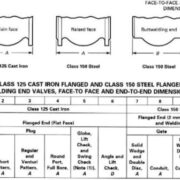Einbaumaße von Flanschventilen ASME B16.10
Wie groß ist die Baulänge eines Kugel-, Durchgangs- oder Absperrschiebers mit Flansch? Der ASME B16.10 Das Diagramm beantwortet diese Frage, da es den Abstand zwischen Einlass und Auslass der gängigsten Flanschventile standardisiert. Der Zweck dieser ASME-Spezifikation besteht darin, die Austauschbarkeit von Ventilen verschiedener Hersteller sicherzustellen.
Anmerkungen:
- (1) Nur Kugel- und Horizontalhubprüfung.
Das Baulängen- und End-zu-Ende-Maß für Rückschlagventile mit Stahlflansch der Klasse 150 in NPS 5 beträgt 330 und in NPS 6 356. - (2) Nur Kugel- und Horizontalhubprüfung.
Das Baulängen- und Endmaß für Rückschlagventile mit Flansch aus Stahl der Klasse 150 in NPS 16 beträgt 864. - (3) Nur Swing-Check.
Allgemeine Hinweise:
- Sofern nicht anders angegeben, sind die Abmessungen in Millimetern angegeben.
- The face-to-face dimension for flanged Valves is the distance between the extreme ends which are the gasket contact surfaces.
- Die End-to-End-Abmessungen gelten für Flanschventile, bei denen sich die Dichtungskontaktflächen nicht an den äußersten Enden des Ventils befinden. Der Abstand zwischen den äußersten Enden wird als End-to-End-Abmessung bezeichnet und gilt für Flanschventile wie: Ringgelenk, großes oder kleines Innengewinde und große oder kleine Nut.
- ASME B16.10 is an essential industry standard for face-to-face and end-to-end dimensions of valves serving across various industrial applications. This standard ensures that valves are manufactured to meet precise dimensional requirements, enabling compatibility and interchangeability in piping systems. In this article, we review key elements of ASME B16.10 including face-to-face and end-to-end dimensions, tolerances, material considerations, and the benefits of adhering to this standard.
What is ASME 16.10?
ASME B16.10, developed by the American Society of Mechanical Engineers, is an industry standard that focuses on standardizing valve dimensions. Specifically, this standard covers the face-to-face and end-to-end dimensions of straightway valves, as well as the center-to-face and center-to-end dimensions of angle valves. By providing these crucial measurements, this standard ensures consistency and interchangeability across valve manufacturers, therefore greatly simplifying the process of valve selection and installation for engineers and technicians.
Purpose and Scope of ASME B16.10
The primary objective of ASME B16.10 is to guarantee installation interchangeability for valves of a particular material, size, type, rating class, and end configuration. Moreover, this standardization is essential for maintaining consistency across various valve manufacturers and applications. By adhering to these standardized dimensions, valve manufacturers can ensure that their products will fit seamlessly into existing systems, regardless of the original equipment manufacturer.
Key Elements of ASME B16.10
ASME B16.10 covers a range of critical aspects that influence the effectiveness and compatibility of valves in industrial settings. The following sections highlight some of these key elements.
Face-to-Face and End-to-End Dimensions
Face-to-face dimension for straightway valves refers to the distance between the sealing surfaces of the valve’s inlet and outlet flanges. For certain valves like butterfly valves, face-to-face dimension may include allowances for gasket or resilient-facing compression. According to this standard, face-to-face dimension applies to valves having the following nominal flange facing identifiers:
- Flat
- 1.5 mm (0.06 in.) raised
- 6.4 mm (0.25 in.) raised
- Large or small male
- Large or small tongue
End-to-end dimension describes the distance between the ends of flanged valves where gasket contact surfaces are not located at the extreme. For example: those with welded or threaded ends. It serves for valves having the following nominal flange facing identifiers:
- Ring joint
- Large or small female
- Large or small groove
The figure below highlights examples of these dimensions for Class 125 Cast Iron and Class 150 Steel.

Courtesy: Gasplus The following table is a snippet of face-to-face and end-to-end dimension specifications of ASME B16.10.
Nominal Valve Size, DN (NPS) Flanged End (Flat Face) Flanged End [1.5 mm (0.06 in.) Raised Face] and Welding End Globe, Lift Check and Swing Check Type B, AWWA C508, A Gate Plug Solid Wedge and Double Disc A Conduit A Solid Wedge, Double Disc, and Conduit, B Short Pattern, A 50 (2) 203 (8.00) 178 (7.00) 178 (7.00) 216 (8.50) 178 (7.00) 65 (2 ½) 216 (8.50) 190 (7.50) 190 (7.50) 241 (9.50) 190 (7.50) 80 (3) 241 (9.50) 203 (8.00) 203 (8.00) 282 (11.12) 203 (8.00) 100 (4) 292 (11.50) 229 (9.00) 229 (9.00) 305 (12.00) 229 (9.00) 125 (5) 330 (13.00) 254 (10.00) – 381 (15.00) 254 (10.00) 150 (6) 356 (14.0) 267 (10.50) 267 (10.50) 403 (15.88) 267 (10.50) Center-to-Face and Center-to-End Dimensions
Center-to-face dimensions apply to angle valves because they have a different configuration in comparison to straightway valves. Similarly, center-to-end dimensions are for angle valves with welded or threaded ends as the following figure shows.

Courtesy: Gasplus The following table is a snippet of center-to-face and center-to-end dimension specifications from ASME B16.10.
Nominal Valve Size, DN (NPS) Flanged End [1.5 mm (0.06 in.) Raised Face] and Welding End,
Angle and Lift Check,
D and E50 (2) 102 (4.00) 65 (2 ½) 108 (4.25) 80 (3) 121 (4.75) 100 (4) 146 (5.75) 125 (5) 178 (7.00) 150 (6) 203 (8.00) Tolerances
ASME B16.10 outlines allowable tolerances for both straightway and angle valves. For straightway valves, it specifies an allowable tolerance of ±1.5 mm for smaller valve sizes (NPS 10 or below), whereas larger valves (NPS 12 and above) have a tolerance of ±3.0 mm. Meanwhile, the specifications for angle valves are half of those for straightway valves of the same size. This means small angle valves, NPS 10 or below, have a tolerance of ±0.75 mm, with larger sizes having a tolerance of ±1.5 mm. These tolerances offer flexibility in valve manufacturing while maintaining quality and precision. This ensures valves can still perform optimally even with slight dimensional variations.
Material Considerations
While ASME B16.10 primarily focuses on dimensional standards, it also references material considerations to ensure compatibility with the intended application. The following sections highlight material types covered in this standard.
Cast Iron Valves
This includes only flanged end valves of the following types:
- Gate, plug, and check valves of Class 125 and 250
- Globe and angle valves of Classes 125 and 250
- Wafer swing check valves of Classes 125 and 250
- Butterfly valves of Class 25 and Class 125
Ductile Iron Valves
For ductile iron valves, the standard also specifies only flanged end valves of Class 150 and Class 300.
Steel and Alloy Valves
This category includes carbon, alloy, stainless steels, and also the nonferrous materials listed in ASME B16.34. It includes flanged, buttwelding, and grooved ends as well as the types of valves intended for assembly between flanges. The types of valves in this category are as follows:
- Gate, globe, angle, check, plug, and also ball valves ranging from Class 150 to Class 2500
- Y-pattern globe and Y-pattern swing check valves of Class 150
- Wafer knife gate valves of Class 150 and Class 300
- Wafer swing check valves from Class 150 to Class 2500
- Absperrklappen of Class 150, Class 300, and Class 600
Benefits of Adhering to ASME B16.10
Adhering to ASME B16.10 offers numerous benefits for manufacturers, engineers, and end-users, as the following sections highlight.
Enhanced Compatibility
Having standard dimensions ensures that valves from different manufacturers are interchangeable. Hence, simplifying the procurement process and reducing downtime during maintenance or replacement. This compatibility is crucial for industries that rely on consistent and reliable valve performance.
Improved Safety and Reliability
By following ASME B16.10, manufacturers can produce valves that meet rigorous safety and reliability standards. Therefore, ensuring effective valve performance under specified operating conditions while reducing the risk of failures and accidents in industrial settings.
Cost Savings
Using standard dimensions reduces the need for custom fittings and modifications during installation, leading to significant cost savings. In addition, the ease of replacing standardized valves minimizes downtime and maintenance costs, contributing to overall operational efficiency.
ASME B16.10 Valves from STV
At STV, we ensure that our valve offerings comply with critical industry standards, including the ASME B16.10, where applicable. Our commitment to quality and precision guarantees that our valves meet stringent dimensional and performance criteria essential for seamless integration into industrial systems. Furthermore, our team members are committed to working with you to assess your project requirements and select the most suitable valves. By choosing QRC Valves, you can be confident you are acquiring high-quality, reliable valves that meet your operational and compliance requirements.



